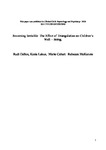Becoming invisible: The effect of triangulation on children's well-being
| dc.contributor.author | dallos, rudi | |
| dc.contributor.author | Lakus, K | |
| dc.contributor.author | Cahart, M-S | |
| dc.contributor.author | mckenzie or stancer, rebecca | |
| dc.date.accessioned | 2016-10-07T09:47:17Z | |
| dc.date.available | 2016-10-07T09:47:17Z | |
| dc.date.issued | 2016-07-01 | |
| dc.identifier.issn | 1359-1045 | |
| dc.identifier.issn | 1461-7021 | |
| dc.identifier.uri | http://hdl.handle.net/10026.1/5575 | |
| dc.description.abstract |
<jats:p>The study explored children’s experience of triangulation in their families. In all, 15 children aged 11–16 years, who were attending an early intervention family therapy service, participated in the study. The children’s understandings and emotional experience of triangulation were explored by comparing their responses to pictures from the Separation Anxiety Test (SAT) and a set of pictures designed for the study depicting a variety of triangulation conflicts in families. An interview regarding the children’s personal family experiences of triangulation was also undertaken and clinical information about the children’s family contexts was also utilised. Statistical analysis was conducted based on eight of children for whom a full data set was available. This indicated that children showed greater levels of anxiety in response to the triangulation as opposed to the separation scenarios. Qualitative analysis supported this finding and revealed that many of the children felt ‘invisible’ due to parents’ pre-occupation with marital conflict, felt caught in the middle of conflicts and coerced to take sides. Although able to describe their reactions and showing greater negative emotional responses to the triadic pictures, they were not consciously aware of the negative impacts of triangulation on their sense of well-being. Clinical implications are discussed with a focus on encouraging child-centred approaches to family therapy.</jats:p> | |
| dc.format.extent | 461-476 | |
| dc.format.medium | Print-Electronic | |
| dc.language | en | |
| dc.language.iso | en | |
| dc.publisher | SAGE Publications | |
| dc.subject | Triangulation | |
| dc.subject | children | |
| dc.subject | families | |
| dc.subject | attachment | |
| dc.subject | story stems | |
| dc.title | Becoming invisible: The effect of triangulation on children's well-being | |
| dc.type | journal-article | |
| dc.type | Journal Article | |
| plymouth.author-url | https://www.webofscience.com/api/gateway?GWVersion=2&SrcApp=PARTNER_APP&SrcAuth=LinksAMR&KeyUT=WOS:000380937300011&DestLinkType=FullRecord&DestApp=ALL_WOS&UsrCustomerID=11bb513d99f797142bcfeffcc58ea008 | |
| plymouth.issue | 3 | |
| plymouth.volume | 21 | |
| plymouth.publication-status | Published | |
| plymouth.journal | Clinical Child Psychology and Psychiatry | |
| dc.identifier.doi | 10.1177/1359104515615640 | |
| plymouth.organisational-group | /Plymouth | |
| plymouth.organisational-group | /Plymouth/Faculty of Arts, Humanities and Business | |
| plymouth.organisational-group | /Plymouth/Faculty of Arts, Humanities and Business/Plymouth Institute of Education | |
| plymouth.organisational-group | /Plymouth/Faculty of Health | |
| plymouth.organisational-group | /Plymouth/REF 2021 Researchers by UoA | |
| plymouth.organisational-group | /Plymouth/REF 2021 Researchers by UoA/UoA23 Education | |
| plymouth.organisational-group | /Plymouth/Users by role | |
| plymouth.organisational-group | /Plymouth/Users by role/Academics | |
| dc.publisher.place | England | |
| dcterms.dateAccepted | 2015-01-23 | |
| dc.identifier.eissn | 1461-7021 | |
| dc.rights.embargoperiod | Not known | |
| rioxxterms.versionofrecord | 10.1177/1359104515615640 | |
| rioxxterms.licenseref.uri | http://www.rioxx.net/licenses/all-rights-reserved | |
| rioxxterms.licenseref.startdate | 2016-07-01 | |
| rioxxterms.type | Journal Article/Review |


